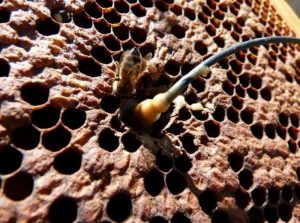It turns out it’s not only ducks that quack. Researchers at Nottingham Trent University used sensitive vibration detectors, called accelerometers, to listen in on Honeybee hives. What they found, is that besides the regular buzzing sounds we all hear; queen honeybees make quacking and tooting noises.
How Bees communicate
Honeybees have several ways to communicate. These include chemically through hormones called pheromones, physically with their waggle dance, and acoustically through sounds they make by vibrating their flight muscles and wings.
Why Queen Bees toot and quack
While the tooting noise from queen bees isn’t a new discovery, it wasn’t exactly clear what these sounds meant. However, thanks to this new study, researchers have discovered that this behaviour plays a crucial role in the honeybees swarming behaviour.
In a honeybee hive, Queen bees are different to worker bees. Queen bees grow in special eggs and are fed with Royal Jelly. There can be several Queen bees growing at any one time, and should these bees be let free, they can become the next leader of the hive. The Queen bees encased in their cells are known as Virgin Queens. These captive bees can only be let out of their cells by worker bees.
Using accelerometers, researchers discovered that established Queen bees emit loud Tooting sounds as they walked through the hive. By monitoring the hive’s behaviour, along with listening in with the accelerometers, researchers were able to de-code what exactly these noises mean, and why it’s such an important behaviour in maintaining an active, healthy hive.

The Tooting sound created by the active queen indicates to the worker bees that they are in the presence of an active Queen, while the quacking from the Virgin Queens lets the worker bees know that there are Queens ready and waiting to step in if needed.
Researchers observed that if half the colony takes off with the current queen, a behaviour known as swarming, then the absence of the Tooting noise signals the release one of the Virgin Queens. Once a new Queen has been released, she will stop quacking and start tooting, to indicate her presence, and prevent any further Virgin Queens from being released. If any further Queens are released, the Queens will fight to the death for the right to rule.
Listen to a Queen Bee toot to her loyal subjects
Now listen to the captive Queens reply!
How can this research help beekeepers?
Researchers say that this work provides strong evidence that the tooting and quacking noises are colony-level communications to aid the drone population in the orderly co-ordination of the release of Queens.
The quacking indicates to the colony that Queens are still available for further swarms. This means that the current Queen and half the colony can swarm, because they know that there are replacement Queens available. If no quacking noises are heard, this indicates to the colony that the current pool of captive Queens is exhausted, so they will not swarm.
Doctor Michael Ramsey, a Nottingham Trent University scientist involved in the study, said that the data gathered has the potential to be used as powerful tool for beekeepers, helping to monitor hives’ behaviours, and predict and prevent swarms. Using similar data collecting methods, beekeepers can be supplied with continuous information on their bees swarming preparations, allowing them to adjust their current swarm-prevention measures, minimising the risk of damage and disruption to their colonies.
To learn more about bees, (including how bees pollinate flowers) check out our “All About Bees” section.


![3 Big Mistakes Beginner Beekeepers Make [And How To Avoid Them!]](https://beekeepingabc.com/wp-content/uploads/2020/11/3-mistakes-beginner-beekeepers-make-90x75.jpg)

![Move over ducks, Queen Bees quack too! [Here’s Why]](https://beekeepingabc.com/wp-content/uploads/2020/06/queen-bee-90x75.png)
![The Flow Hive 2 Review [ Vs. The Classic Flow Hive]](https://beekeepingabc.com/wp-content/uploads/2020/02/Flow-Hive-2-90x75.jpg)
![How Bees Fly [10 Facts About How, When, and Why]](https://beekeepingabc.com/wp-content/uploads/2019/12/A-Bee-Flying-90x75.jpg)